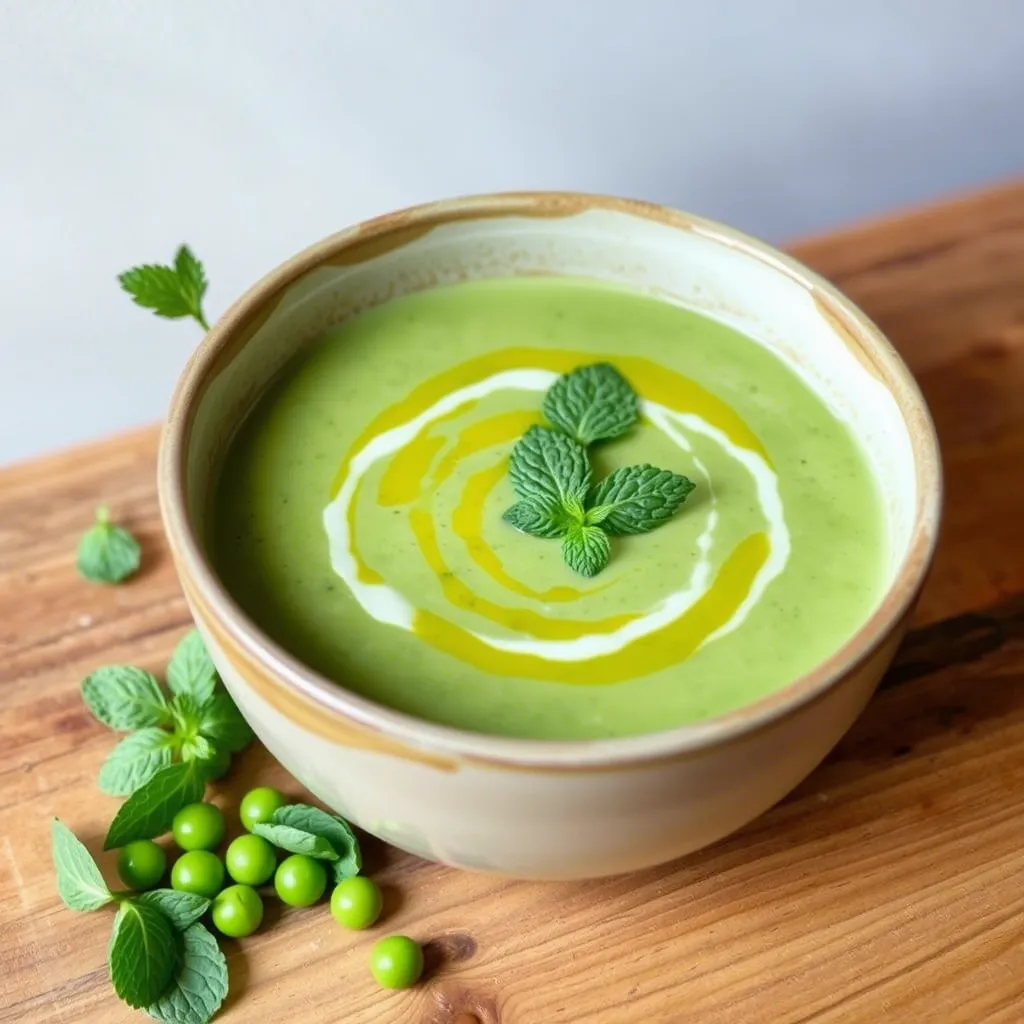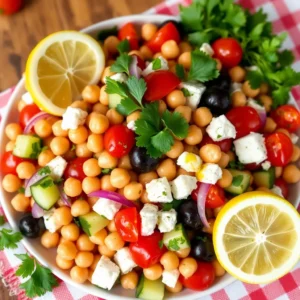Why You’ll Love This Fresh Pea and Mint Soup
There’s something undeniably comforting about a bowl of soup, especially when it’s packed with fresh ingredients that scream springtime. If you’re someone who loves the idea of cozy meals but also wants to keep things light and refreshing, then this fresh pea and mint soup is going to become your new favorite. It’s one of those recipes that feels like a warm hug on a chilly day or a cool breeze on a hot afternoon—depending on how you serve it. And the best part? It’s incredibly easy to make, even for someone who considers themselves more of a “microwave chef” than a seasoned cook.
Let’s face it: life can be busy, and sometimes we need a meal that doesn’t require hours in the kitchen or a dozen obscure ingredients. That’s where this spring pea and mint soup comes in. It’s simple, satisfying, and ready in under an hour. The combination of sweet peas and bright, aromatic mint creates a flavor profile that’s both familiar and exciting. Whether you’re looking for a quick lunch, a starter for dinner, or just a way to use up leftover veggies from the farmers’ market, this recipe checks all the boxes.
One of the main reasons I love this soup is its versatility. It’s perfect for those days when you want something hot and hearty, but it also works wonders as a chilled soup on warmer days. Just adjust the serving temperature, and you’ve got a dish that transitions seamlessly from winter to summer. Plus, it’s incredibly forgiving—if you don’t have fresh peas, frozen ones work just fine. And if you’re not a huge fan of mint, you can always tone it down or swap it out for another herb like parsley or dill.
But what really sets this fresh pea and mint soup apart is how it brings together the best parts of comfort food and healthy eating. It’s packed with nutrients from the peas, which are a great source of protein and fiber, while the mint adds a refreshing kick that makes each spoonful feel lighter than air. This isn’t just a soup—it’s a celebration of spring flavors in their purest form. And let’s be honest, who doesn’t love a recipe that feels fancy enough to serve at a dinner party but is simple enough to make on a weeknight?
If you’re still on the fence, here’s a little story to convince you. A few years ago, I was hosting a casual dinner for friends, and I wanted to serve something that felt special without being too complicated. I decided to try this pea and mint soup , and it was a hit. Everyone raved about how fresh and vibrant it tasted, and I couldn’t believe how quickly it came together. Since then, it’s become a staple in my kitchen, and I’ve made it countless times for everything from family dinners to weekend brunches.
And if you’re looking for other ways to enjoy spring vegetables, check out my Spring Pea and Asparagus Risotto for a different take on seasonal flavors.
The Story Behind This Fresh Pea and Mint Soup
The first time I made this fresh pea and mint soup , I was in the middle of a chaotic week. Between work deadlines and trying to keep up with the kids’ schedules, I needed a quick and easy meal that didn’t require much effort. I had a bag of frozen peas in the freezer (always a good thing to have on hand) and a handful of fresh mint from the garden. I figured, why not throw them into a pot and see what happens? Little did I know, that simple experiment would become one of my most requested dishes.
As I stirred the soup on the stove, the aroma of the mint began to fill the kitchen, and I could almost hear the gentle hum of spring. It was a reminder that no matter how hectic life gets, there’s always a moment to pause and savor the beauty around us. When I took my first spoonful, I was instantly transported to a sunlit afternoon in a garden, surrounded by blooming flowers and the sound of birds chirping. It was as if the soup had captured the very essence of spring in every spoonful.
The response from my family was immediate and enthusiastic. My youngest daughter, who often turns her nose up at green vegetables, actually asked for seconds. I was thrilled! It wasn’t just the taste that won her over; it was the way the soup felt so light and refreshing, yet deeply satisfying. I realized that this recipe had the power to bring people together, creating moments of joy and connection through food.
Since that first batch, this fresh pea and mint soup has become a regular feature in our home. We’ve served it at weekend gatherings, where it’s always the first to disappear, and even taken it to potlucks where it’s been met with rave reviews. One of my favorite memories is when I brought it to a neighborhood picnic during the peak of spring. The vibrant green color and the refreshing scent of mint drew everyone in, and I watched as friends and neighbors gathered around, sharing stories and laughter while enjoying the soup. It was a beautiful reminder of how food can create community and foster connections.
Over time, I’ve learned to tweak the recipe based on what’s available in our garden or what the kids are craving. Sometimes I add a splash of cream for extra richness, while other times I keep it light with just a touch of olive oil. Each variation tells its own story, reflecting the seasons and the moods of our household. It’s amazing how a simple soup can evolve and adapt, becoming a canvas for creativity and expression in the kitchen.
This fresh pea and mint soup isn’t just a meal; it’s a celebration of the changing seasons and the joy of cooking with fresh, local ingredients. It reminds me of the importance of slowing down and appreciating the small things in life, like the sweetness of a perfectly ripe pea or the fragrant burst of mint. Every time I make it, I’m reminded of that initial spark of inspiration that led to this delightful creation, and I hope to share that same sense of wonder with anyone who tries it.
So whether you’re looking for a comforting meal on a rainy day or a refreshing start to a summer evening, this fresh pea and mint soup is sure to bring a smile to your face and warmth to your heart. It’s a testament to the magic that happens when you embrace the season and let your creativity flow in the kitchen. And who knows? Maybe your next cherished memory will be born from a humble bowl of soup, just like mine was.
Ingredients
Creating this fresh pea and mint soup requires only a handful of simple ingredients that come together to form a vibrant and delicious dish. Let’s break down what you’ll need and explore some helpful tips for substitutions and ingredient variations.
Fresh or Frozen Peas
The star of the show is, of course, the peas. Fresh peas are ideal, especially if they’re in season, as they offer a sweeter flavor and a tender texture. However, if fresh peas aren’t available, frozen peas are a fantastic alternative. They retain their sweetness and are convenient for last-minute meals. Just make sure to thaw them slightly before using to avoid waterlogging the soup. If you’re short on time, you can add them directly from the freezer during the cooking process; they’ll soften as they heat up.
Vegetable Broth
A good quality vegetable broth forms the base of this soup, adding depth and richness. Look for low-sodium options if you’re watching your salt intake. If you don’t have any on hand, you can easily substitute chicken broth for a slightly different flavor profile. For a more robust taste, consider using homemade broth, which allows you to customize the flavors to your liking.
Onion
Onion is essential for building flavor in the soup. I recommend using yellow onions for their mild sweetness, which complements the peas beautifully. If you prefer a bit more bite, white onions work well too. To enhance the flavor, sauté the onion until it becomes translucent; this step helps to unlock the natural sugars and adds a lovely depth to the soup.
Fresh Mint
Fresh mint is non-negotiable in this recipe. Its bright, refreshing flavor elevates the soup and gives it that signature spring vibe. If you don’t have fresh mint, you can use dried mint, but keep in mind that it will be more potent. Use about one-third the amount called for in the recipe and add it earlier in the cooking process to allow the flavors to meld. Alternatively, you can substitute other herbs like fresh parsley or dill for a different twist. Both herbs offer unique flavors that pair well with peas, so feel free to experiment!
Cream or Olive Oil
To give the soup a creamy texture, I suggest using a splash of cream. Whole milk or half-and-half can be used as alternatives if you prefer a lighter version. For a vegan option, coconut milk or a plant-based creamer can be substituted. If you want to keep the soup dairy-free altogether, simply skip the cream and rely on the natural sweetness of the peas for richness. Instead of cream, you can also use a bit of olive oil to add body and flavor. Extra virgin olive oil is particularly nice, as it imparts a fruity note that enhances the overall taste.
Seasonings
Basic seasonings like salt and freshly ground black pepper are crucial for balancing the flavors. Don’t forget to taste as you go and adjust accordingly. If you want to add a bit more complexity, consider incorporating garlic or ginger. These spices can elevate the soup’s flavor profile and add a delightful warmth. A pinch of cayenne pepper can also introduce a subtle heat that complements the sweetness of the peas.
Optional Add-Ins
To further personalize your soup, think about adding optional ingredients that reflect your preferences or what you have on hand. A dollop of Greek yogurt or a swirl of sour cream can add a tangy contrast to the sweetness of the peas. Toasted nuts or seeds, such as pumpkin seeds or slivered almonds, provide a delightful crunch and additional texture. Fresh herbs like chives or cilantro can be sprinkled on top for an extra layer of freshness and visual appeal.
By understanding these ingredients and their roles in the recipe, you can confidently prepare this fresh pea and mint soup while making adjustments to suit your taste and dietary needs. Remember, the beauty of cooking lies in experimentation and personalization, so don’t hesitate to get creative with your choices!
Execution
Now that we’ve gathered our ingredients, it’s time to dive into the step-by-step execution of this fresh pea and mint soup . With just a few simple steps, you’ll transform these humble ingredients into a vibrant and comforting dish that’s sure to impress.
Step 1: Sauté the Aromatics
Begin by heating a tablespoon of olive oil in a large pot over medium heat. Once the oil is warm, add a finely chopped onion and sauté it until it becomes translucent and lightly golden, about 5 minutes. This step is crucial as it builds the foundation of flavor for the soup. If you’re using garlic, now is the time to add it for an extra layer of depth. Cook for another minute, stirring frequently to prevent burning.
Step 2: Add the Peas
Next, add your fresh or thawed peas to the pot. Stir them into the onions and let them cook for a few minutes, allowing the flavors to meld together. If you’re using frozen peas, you can add them directly from the freezer; they’ll soften as they heat up. This is a great opportunity to engage with the cooking process, as you can watch the peas begin to release their natural sweetness.
Step 3: Incorporate the Broth
Pour in your vegetable broth, ensuring it covers the peas and onions completely. Bring the mixture to a gentle simmer, allowing the flavors to develop. If you’re using chicken broth instead, it will contribute a richer taste that complements the peas beautifully. Let the soup simmer for about 10 minutes, giving the peas time to soften and the broth to infuse the mixture with its savory notes.
Step 4: Blend to Perfection
Once the peas are tender, it’s time to blend the soup. Using an immersion blender, carefully blend the mixture until smooth. If you don’t have an immersion blender, transfer the soup in batches to a traditional blender, making sure to vent the lid to avoid splattering. Blend until you achieve a silky consistency. This step is vital for creating that luxurious texture that defines a great soup.
Step 5: Add the Mint and Cream
With the soup now blended, stir in a generous amount of fresh mint leaves. The brightness of the mint will awaken the senses and add a refreshing twist to the dish. At this point, you can also add your choice of cream or milk to give the soup a creamy finish. If you’re using coconut milk for a vegan version, it will lend a delightful richness while keeping the soup dairy-free. Adjust the amount according to your preference, aiming for a balance between the sweetness of the peas and the creaminess of the soup.
Step 6: Season to Taste
Now it’s time to season the soup. Begin by adding a pinch of salt and a few grinds of black pepper. Taste the soup and adjust the seasoning as needed. If you want to enhance the flavor further, consider adding a squeeze of lemon juice or a dash of cayenne pepper for a hint of heat. This is where your personal touch comes in, so feel free to experiment with your favorite seasonings.
Step 7: Serve and Garnish
Once the soup is seasoned to your liking, it’s ready to serve. Ladle the soup into bowls and garnish with a sprinkle of fresh herbs, a drizzle of olive oil, or a dollop of Greek yogurt for added flair. For an extra touch, you can top it with a few toasted nuts or seeds, which provide a delightful crunch and a pop of color.
Serving this fresh pea and mint soup is a wonderful way to showcase the beauty of seasonal ingredients. Whether you choose to serve it hot on a chilly day or chilled on a warm afternoon, it’s a versatile dish that can be enjoyed throughout the year. Pair it with crusty bread or a simple salad for a complete meal that celebrates the flavors of spring.
In the spirit of culinary exploration, remember that this recipe is a starting point. Feel free to add your own twists, such as a splash of sherry or a handful of baby spinach for added nutrition. The key is to enjoy the process and savor the flavors that emerge as you create your own version of this beloved soup. So grab your ladle and get ready to enjoy a bowl of sunshine in every sip!
Additional Tips
Creating the perfect fresh pea and mint soup involves not just following a recipe but also understanding how to enhance the flavors and textures to suit your palate. Here are some practical tips and tricks that will help you elevate your soup game and ensure every batch is a success.
Choosing the Right Peas
While fresh peas are ideal for this soup, you might find yourself in a situation where you only have frozen peas on hand. In such cases, it’s important to remember that frozen peas can be just as delicious if prepared correctly. Thaw them slightly before adding them to the pot to prevent excess moisture from diluting the soup. If you’re short on time, you can add them directly from the freezer during the cooking process; they’ll soften as they heat up. Just keep an eye on the cooking time to ensure they don’t become overly mushy.
Blending Techniques
Blending is a critical step in achieving that silky texture that defines a great soup. If you’re using an immersion blender, be sure to hold the pot steady and blend in slow, deliberate movements to avoid splattering. If you’re using a traditional blender, work in small batches and never fill it more than halfway to prevent overflow. For a smoother consistency, you can pass the soup through a fine-mesh sieve after blending. This will remove any lumps and create a velvety finish that’s perfect for serving.
Flavor Enhancements
To truly make this soup your own, consider experimenting with flavor enhancements. A splash of sherry or white wine can add a delightful depth and complexity. If you’re feeling adventurous, try adding a handful of baby spinach or kale just before serving; they’ll wilt quickly and add a nutritional boost without overpowering the delicate flavors. For a touch of heat, a pinch of red pepper flakes can add a subtle kick that complements the sweetness of the peas.
Serving Suggestions
When it comes to serving this fresh pea and mint soup , the possibilities are endless. While it’s delicious on its own, pairing it with complementary sides can elevate the experience. Consider serving it with a slice of crusty bread or a simple green salad for a balanced meal. For a heartier option, you could add a dollop of Greek yogurt or a swirl of sour cream on top, which provides a tangy contrast to the sweetness of the peas. If you’re looking for a vegan version, opt for coconut milk or a plant-based creamer instead of dairy.
Storage and Reheating
Leftover soup can be stored in an airtight container in the refrigerator for up to four days. When reheating, do so gently over low heat to maintain the soup’s integrity. If the soup thickens upon chilling, simply add a splash of broth or water to restore its desired consistency. For a cold version, chill the soup in the refrigerator for a few hours before serving, and consider adding a squeeze of lemon juice for an extra zing.
Troubleshooting Common Issues
If your soup ends up too thin, you can thicken it by simmering it for a few more minutes or adding a small amount of flour or cornstarch mixed with water to create a slurry. Conversely, if it’s too thick, gradually add more broth or water until you reach your preferred consistency. If the flavors seem flat, a splash of vinegar or lemon juice can brighten things up. Always taste as you go and adjust the seasoning accordingly.
Customizing Your Recipe
Don’t be afraid to put your own spin on this fresh pea and mint soup . Experiment with different herbs and spices to match your taste preferences. For example, adding a bit of dill or basil can create a unique flavor profile that reflects your personal style. You can also incorporate other vegetables like carrots or celery for added sweetness and texture. The key is to have fun and make the soup your own, turning it into a reflection of your culinary journey.
By following these tips and tricks, you’ll not only enhance your fresh pea and mint soup but also gain confidence in the kitchen. Remember, cooking is an art, and every variation you create adds to the rich tapestry of flavors that define your culinary experience. So go ahead, embrace your creativity, and enjoy the process of making this delightful soup your own!
FAQs
Can I use dried herbs instead of fresh mint?
Yes, you can use dried herbs as a substitute for fresh mint, but keep in mind that the flavor will be more concentrated. When using dried herbs, reduce the quantity to about one-third of what the recipe calls for. Add them earlier in the cooking process to allow the flavors to meld properly. While fresh mint offers a vibrant and aromatic quality that’s hard to replicate, dried herbs can still provide a decent substitute if you’re in a pinch. Just be sure to taste as you go and adjust the seasoning accordingly to ensure the soup remains balanced.
How long does the soup last in the fridge?
Freshly made pea and mint soup can be stored in an airtight container in the refrigerator for up to four days. To maintain its quality, ensure the container is sealed tightly to prevent any odors from seeping in. If you notice the soup thickening after refrigeration, you can add a splash of broth or water to restore its desired consistency. When reheating, do so gently over low heat to preserve the flavors and textures. If you want to extend the shelf life, you can freeze the soup for up to three months. Just make sure to leave some headspace in the container to allow for expansion during freezing.
Can I make this soup in a slow cooker or Instant Pot?
Absolutely! Making this pea and mint soup in a slow cooker or Instant Pot is a convenient option that allows you to set it and forget it. For the slow cooker method, simply combine all the ingredients in the pot and cook on low for 6-8 hours or high for 3-4 hours. Once the soup is ready, blend it to your desired consistency. If you’re using an Instant Pot, select the “soup” setting and cook for about 10-15 minutes. After cooking, allow the pressure to release naturally for 10 minutes before opening the lid. Both methods yield a delicious result, making it easy to prepare a comforting bowl of soup with minimal effort.
What are some good side dishes to pair with this soup?
This pea and mint soup pairs beautifully with a variety of side dishes that complement its fresh and vibrant flavors. A simple green salad with a light vinaigrette is an excellent choice, providing a refreshing contrast to the soup. For a heartier option, consider serving it with crusty bread or a slice of grilled cheese sandwich. If you’re looking for something more substantial, a grain like quinoa or brown rice can add a satisfying element to your meal. Additionally, roasted vegetables or a charcuterie board can enhance the dining experience, offering a range of textures and flavors that harmonize with the soup.
Can I serve this soup cold?
Yes, this pea and mint soup can be served cold, especially during warmer weather. Chilling the soup in the refrigerator for a few hours before serving will enhance its refreshing qualities. If you plan to serve it cold, consider adding a squeeze of lemon juice for an extra zing. You can also garnish it with a dollop of Greek yogurt or a swirl of sour cream for added richness. Cold soups like gazpacho are popular in many cultures, and this version is no exception. Just make sure to adjust the seasoning after chilling, as cold temperatures can dull the flavors. Enjoy your pea and mint soup as a delightful appetizer or a light lunch that brings a touch of spring to your table.
Where can I find more spring-inspired recipes?
For more spring-inspired recipes that celebrate the season’s fresh flavors, check out my Spring Pea and Asparagus Risotto . This dish features similar ingredients and highlights the vibrant produce of spring, making it a perfect addition to your repertoire. Additionally, you can explore my collection of vegetable soups for other creative takes on seasonal ingredients. By experimenting with different recipes, you’ll discover new ways to enjoy the bounty of spring while bringing your culinary skills to life in the kitchen.



